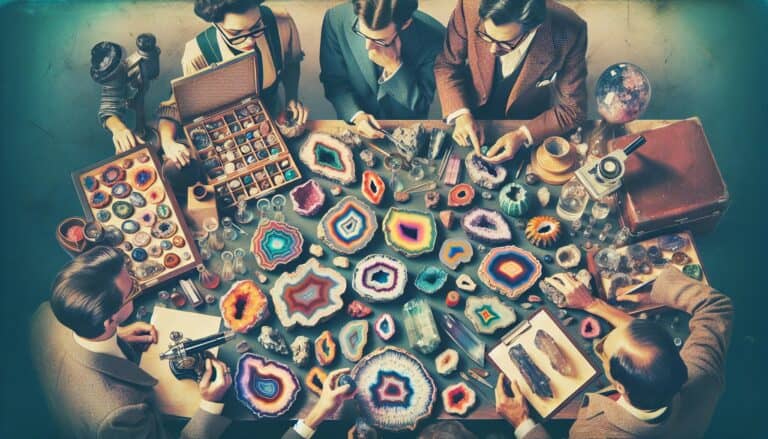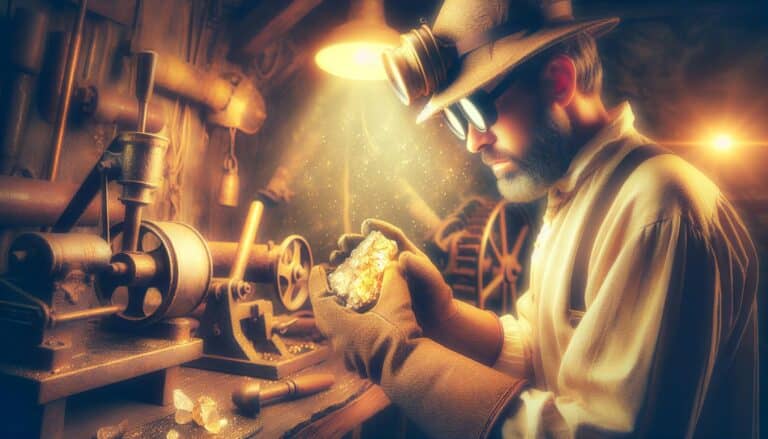Discovering the secrets of kyanite is like unlocking a treasure chest of the mineral world.
You’re about to embark on a journey to identify this stunning gemstone, renowned for its striking blue hues and unique properties. Whether you’re a seasoned collector or a curious newcomer, understanding kyanite’s characteristics is key to recognizing its true beauty.
You’ll find that kyanite isn’t just another pretty stone; it’s a mineralogist’s dream with distinct features that set it apart. From its unmistakable color to its unusual hardness variance, knowing what to look for is essential.
Get ready to dive into the world of kyanite, where clarity and color reign supreme.
To identify kyanite, look for its distinct deep blue color and bladed crystal structure. Kyanite’s unique feature is its variable hardness of 4.5 to 7 on the Mohs scale, depending on the direction. It is non-magnetic, leaves a white streak, and is typically translucent to opaque.
How to Identify Kyanite Through Testing
When you’re trying to confirm if the stone in your possession is kyanite, various tests can be your best allies. Each test will give you clues on whether your specimen is the real deal.
Visual Inspection
Start with a thorough visual inspection. Kyanite’s most distinguishing feature is its deep blue color, although it can also come in green, black, and orange. Look for a bladed crystal structure and if present, it’s a strong indicator that you might have kyanite.
The Streak Test
The streak test can help determine the powder color of your gemstone. Rub your stone against a piece of unglazed porcelain and observe the color of the streak it leaves behind. Kyanite should leave a white streak, which can confirm your suspicions without damaging the specimen.
Magnet Test
Hold a magnet near your stone. Kyanite is not magnetic, so lack of magnetism can be a confirming characteristic. Remember that some minerals may have iron impurities, which can attract a magnet, but pure kyanite will not.
Hardness Test
Kyanite has a unique anisotropic hardness, which means it has different hardnesses on different sides. On the Mohs scale, kyanite’s hardness can vary from 4.5 to 7. Try scratching your stone with objects of known hardness to get an indication of its hardness.
Birefringence Test
Using a petrographic microscope, you can examine kyanite for birefringence. This property causes a doubling of the image when looking through the stone. Birefringence in kyanite is due to its anisotropic crystal structure.
Checking The Diaphaneity
Look at how light passes through your stone. Kyanite ranges from transparent to translucent. Hold the stone up to the light and check its transparency; this could guide you towards identifying it correctly.
Single or Double Refraction
Kyanite is a triclinic mineral, meaning it has single-axis refraction. When light is passed through it, there should not be a double refraction effect, unlike other gemstones that may show this characteristic.
Refractive Index Test
For more conclusive evidence, measure the refractive index (RI) of the stone. Kyanite has an RI between 1.71 and 1.73. Precise instruments at a jeweler or gemological laboratory can determine the RI accurately.
Finding The Specific Gravity
The specific gravity of kyanite is typically between 3.56 and 3.67. To measure this, you would need a hydrostatic balance or a specific gravity kit which compares the weight in air to the weight in water.
Identifying Kyanite in the Field
When you’re in the field, look for kyanite within metamorphic rocks. It often forms in schists and gneisses due to high-pressure conditions. Presence in these rocks can be a good indicator of kyanite.
Recognizing Potential Kyanite Rocks
Potential kyanite rocks may not always clearly display the blue color. Look for signs of metamorphic activity and the distinct bladed crystals. Even in its rough state, kyanite crystals will often exhibit a characteristic shape and formation pattern.
Physical Characteristics of Kyanite

Kyanite is easily identifiable by its distinctive physical characteristics. Its most remarkable feature is the bladed crystal form that it typically exhibits. You’ll notice these slender, elongated crystals often taper at the ends, giving them a unique and easily recognizable shape. The color of kyanite ranges from vibrant blue to green, with the blue variant being the most popular and sought after. However, shades of kyanite can also include colorless, white, gray, yellow, pink, and orange, with the saturation of color often enhancing its value.
The mineral’s surface generally displays a pearly to white luster when held under light. This luster, coupled with its vibrant tones, contributes to kyanite’s allure in jewelry making. Another intriguing property is its anisotropism; kyanite has different hardness depending on the crystallographic direction. On the Mohs scale, it can be as soft as 4.5 parallel to the length of the crystal and as hard as 7.5 when scratched perpendicularly.
The cleavage of kyanite is perfect in one direction and good in two others, leading to its elegant and elongated shapes. These cleavages are vital for gem cutters to consider when shaping the stone for use in adornments.
- Bladed crystal form
- Color variety: blue, green, colorless, white, gray, yellow, pink, orange
- Pearly to white luster
- Anisotropic hardness (4.5 – 7.5 on the Mohs scale)
- Perfect to good cleavage
When handling kyanite, you’ll find it has a brittle tenacity, meaning it can break with relative ease compared to other minerals. This is particularly important to bear in mind if you’re using kyanite in jewelry, as it requires careful handling to avoid damage. Additionally, kyanite is a non-conductive mineral, reaffirming its identity among similar-looking stones that may exhibit differing electrical properties.
How Are Kyanite Formed?
Kyanite is typically formed under the high-pressure and high-temperature conditions found in metamorphic rocks. It’s a result of the regional metamorphism of clay-rich sedimentary rocks, and you’ll often find it accompanies other metamorphic minerals like garnet, staurolite, and sillimanite.
- High-Pressure Metamorphism: This type of metamorphism occurs deep within the Earth’s crust, where temperatures and pressures transform sedimentary rocks into new types of rocks.
- Common Environments: Kyanite formation often takes place in areas with significant mountain-building activity, making places with historical geological upheaval hotspots for kyanite deposits.
The process of kyanite formation can be complex. The original rocks that kyanite is formed from, mainly shales and clays, are subjected to intense pressure but comparatively lower temperatures. This directional pressure, or differential stress, creates the ideal conditions for kyanite to crystallize while preserving its distinctive bluish color and elongated crystal structure.
| Factor | Condition | Outcome |
|---|---|---|
| Pressure | High | Kyanite crystal formation |
| Temperature | Moderately High | Stability of bluish color |
| Environment | Regional Metamorphism | Association with other minerals |
Keep in mind that kyanite’s formation conditions are quite specific, and while they’re not unique, they’re less common than the conditions that create more widespread minerals. This is part of what makes kyanite special and sought-after both by mineral collectors and industry professionals. Understanding these geological processes enriches your rock-hounding experience, allowing you to better predict where kyanite might be lying in wait for your discovery.
Preparation for Kyanite Hunting
Before you set out on your adventure to find this alluring blue mineral, make sure you’re well-equipped. Successful kyanite hunting requires preparation—both in knowledge and in supplies.
Gathering the Right Tools
To maximize your chances of identifying kyanite in the field, you’ll need a basic kit of tools. Here’s what you should pack:
- Geologist’s hammer for carefully breaking rocks to reveal potential kyanite samples
- Chisel to pry kyanite from its host rock without damaging the crystal
- Safety goggles to protect your eyes from flying rock chips
- Hand lens or magnifying glass for close-up inspection of minerals
- Hardness test kit, which helps in performing the hardness test on the spot
- Maps and a compass for navigating to known kyanite locations
- Field guidebook on minerals to compare and confirm your findings
- GPS device or a smartphone with a GPS app to mark the coordinates of your discoveries
Having this equipment on hand will not only help you in the identification process but also in accurately locating and retrieving kyanite specimens.
Safety Considerations
No mineral is worth compromising your safety. As you prepare for your kyanite hunt, keep these safety tips in mind:
- Always wear protective gear like gloves and safety glasses when handling rocks and tools
- Inform someone of your whereabouts and expected return time
- Carry a first aid kit and know how to use it
- Be aware of the terrain and weather conditions of the area you’ll be exploring
- Stay hydrated and prepare for environmental factors like sun exposure or cold temperatures
- Ensure you have the proper permits if you’re collecting on public lands or private property; be respectful of the land and follow leave-no-trace principles
By being properly prepared and mindful of these tips, you’ll ensure that your kyanite hunting experience is not only fruitful but also safe.
Handling and Care of Found Kyanite

Once you’ve successfully identified and collected kyanite specimens, it’s crucial to know the proper methods to handle, clean, and store these minerals to maintain their natural beauty and value.
Cleaning Kyanites
Kyanite’s variable hardness can make cleaning a delicate task. Avoid using harsh chemicals or ultrasonic cleaners, as they can damage the stone. Gentle cleaning is key. Here’s a step-by-step guide for cleaning your kyanite:
- Start by removing any dirt using a soft brush.
- Rinse the kyanite with lukewarm water; hot or cold extremes could cause fractures.
- Use a mild soap if necessary, and then thoroughly rinse to remove any soap residue.
- Dry your kyanite with a soft, lint-free cloth.
Storing Kyanites
Proper storage is essential to protect your kyanite gems from scratches and damage. Consider the following tips for storing your kyanite:
- Wrap each piece in a soft cloth or place it inside a fabric-lined box to prevent scratching.
- Keep kyanite away from harder stones like diamonds or quartz, which might scratch it.
- Avoid storing kyanite in direct sunlight as prolonged exposure can fade its vibrant colors.
By following these handling and care instructions, your kyanite specimens will retain their allure for years to come. Remember, the value of kyanite isn’t just in its beauty or geological significance; it’s also in how well you care for it after discovery.
Conclusion: Confirming Kyanite is Real
With the right knowledge, you’re now equipped to identify kyanite with confidence.
Remember the importance of gentle handling and the need for proper storage to keep your specimens in pristine condition. By avoiding harsh chemicals and direct sunlight, you’ll ensure that the unique charm of kyanite continues to shine. Whether you’re a collector or a gem enthusiast, the allure of this mineral is undeniable.
Treasure your kyanite finds and enjoy the natural beauty they bring to your collection.




![Alaska Rockhounding Sites in [year]: Locations & Gems](https://observationhobbies.com/wp-content/uploads/2024/01/w8vGE4zrwO-0XFwKV2tuI-768x439.jpg)
![Kansas Rockhounding Sites in [year]: Best Spots & Treasures](https://observationhobbies.com/wp-content/uploads/2024/01/MEpyAlU09VN0IV9zhK62K-768x439.jpg)

